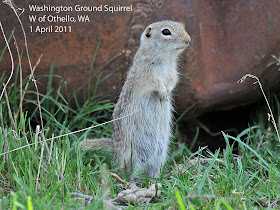It’s hard to conceive of a species spending most of its life asleep, but that’s the case for the spring ground squirrels.
Ground squirrels feed on herbaceous vegetation, and many of them are active throughout the summer and then hibernate during the winter. Some ground squirrels, however, live in arid deserts or grasslands in which lush growing vegetation is present only during the spring or during a summer rainy season. These species are active only during that time, so they are active above ground for only about a third of the year.
Two species that exemplify this scenario are the Washington Ground Squirrel (Spermophilus washingtoni) and Piute Ground Squirrel (Spermophilus mollis). Both are small, short-tailed species. Piute Ground squirrels occur in a limited area of sagebrush steppe in southern Washington between the Cascades and the Columbia River. Washington Ground Squirrels occur east of that river in the Columbia Basin. Both species have declined substantially in recent years as their habitat has been lost to agriculture.
Belding's Ground Squirrel (Spermophilus beldingi) is a slightly larger and more southerly species of the high desert in eastern Oregon and northern California. It has adapted very well to agriculture, so it is still abundant, but its life history is much like that of the other two.
Washington Ground Squirrels have litters of about eight young. They are born in late winter and emerge from their burrows about a month after the adults. A visitor to a ground squirrel colony around the beginning of April is treated to the sight of playful young on all sides, while the adults go about the business of serious eating.
After a few months of activity, with an abundance of fresh salads on the daily menu, first the adults and then the juveniles retire back into their burrows and spend the summer in a state of torpor called aestivation. Aestivation then grades into the usual winter hibernation. The longest an individual of these species spends above ground is about four months. One adult Washington Ground Squirrel in captivity was dormant for 244 days.
Juveniles grow to adult weight in two months after leaving the burrow. All individuals begin to deposit fat 6-8 weeks after emerging and end up with lipids comprising about 65% of their body weight when they go into the burrow for good. They then live through the summer, fall and winter on the fat deposited during the spring.
High temperature and low humidity are stressful on any animal, and as there is no new growth on the plants they favor, the spring-active ground squirrels have no source of water during the summer; thus aestivation. Aestivation is an adaptation for survival in hot, dry climates, just as hibernation is an adaptation for survival in cold climates. These small animals use both of these strategies, surviving by the fine tuning of their seasonal activity to their climate. How will global warming affect them?
Dennis Paulson
Dennis Paulson





No comments:
Post a Comment